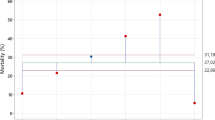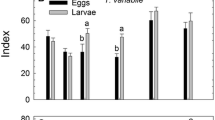Abstract
Dry-cured ham is protected from arthropod infestations using the fumigant methyl bromide. Tyrophagus putrescentiae (Schrank), known as the cheese or ham mite, decreases the quality and quantity of dry-cured hams during the aging process and is a serious economic threat to dry-cured ham companies. Methyl bromide is a strong ozone-depleting substance that is scheduled to be phased out from most uses in the near future. Consequently, developing effective, feasible, and economic alternatives to methyl bromide is the main purpose of the current project. More than ten registered residual pesticides were assessed for toxicity with glass vials treated with different concentrations. Twenty mites were transferred to each vial for 24 h of exposure on contact. Persistence of three of these residual pesticides was evaluated over a 2-month period by applying the recommended label rates to different surfaces. Results indicated that the commercial products of deltamethrin plus chlorpyrifos-methyl, chlorphenapyr, and malathion showed promising results for contact toxicity against mites, and chlorphenapyr was highly effective at very low concentrations. Chlorphenapyr was the only pesticide applied to metal, concrete, and wood that was effective at controlling ham mites for 8 weeks. These pesticides are currently registered for use in similar contexts, so they could be considered as new potential control measures for ham mites in ham plants.
Similar content being viewed by others
References
Arthur FH (2008) Efficacy of chlorfenapyr against Tribolium castaneum and Tribolium confusum (Coleoptera: Tenebrionidae) adults exposed on concrete, vinyl tile, and plywood surfaces. J Stored Prod Res 44:145–151. doi:10.1016/j.jspr.2007.08.005
Arthur FH (2012) Lethal and sub-lethal effects from short-term exposure of Rhyzopertha dominica on wheat treated with storicide II®. J Pest Sci 85:261–265. doi:10.1007/s10340-011-0396-8
Arthur FH (2013) Dosage rate, temperature, and food source provisioning affect susceptibility of Tribolium castaneum and Tribolium confusum to chlorfenapyr. J Pest Sci 86:507–513. doi:10.1007/s10340-013-0495-9
Arthur FH (2015) Food source effect and residual efficacy of chlorfenapyr as a surface treatment on sealed and unsealed concrete. J Stored Prod Res 64:65–71. doi:10.1016/j.jspr.2015.08.007
Arthur FH, Liu S, Zhao B, Phillips TW (2009) Residual efficacy of pyriproxyfen and hydroprene applied to wood, metal and concrete for control of stored-product insects. Pest Manag Sci 65:791–797. doi:10.1002/ps.1756
Assis CPOD (2011) Toxicity of essential oils from plants towards Tyrophagus putrescentiae (Schrank) and Suidasia pontifica Oudemans (Acari: Astigmata). J Stored Prod Res 47:311–315. doi:10.1016/j.jspr.2011.04.005
Athanassiou C, Palyvos N, Eliopoulos P, Papadoulis GT (2002) Mites associated with stored seed cotton and related products in Greece. Phytoparasitica 30:387–394
Athanassiou CG, Arthur FH, Throne JE (2009) Efficacy of grain protectants against four psocid species on maize, rice and wheat. Pest Manag Sci 65:1140–1146. doi:10.1002/ps.1804
Athanassiou C, Athanassiou N, Kavallieratos A, Sciarretta N, Palyvos P, Trematerra (2011) Spatial associations of insects and mites in stored wheat. J Econ Entomol 104:1752–1764. doi:10.1603/EC10376
Athanassiou CG, Kavallieratos NG, Arthur FH, Throne JE (2013) Efficacy of a combination of beta-cyfluthrin and imidacloprid and beta-cyfluthrin alone for control of stored-product insects on concrete. J Econ Entomol 106:1064–1070. doi:10.1603/EC12406
Athanassiou CG, Kavallieratos NG, Arthur FH, Throne JE (2014) Residual efficacy of chlorfenapyr for control of stored-product psocids (Psocoptera). J Econ Entomol 107:854–859. doi:10.1603/EC13376
Aygun O, Yaman M, Durmaz H (2007) A survey on occurrence of Tyrophagus putrescentiae (Acari: Acaridae) in Surk, a traditional Turkish dairy product. J Food Eng 78:878–881. doi:10.1016/j.jfoodeng.2005.11.029
Collins DA (2003) The efficacy of flufenoxuron, azadirachtin and a diatomaceous earth, when admixed with oilseed rape, against storage mite pests. Proceedings of the eighth international working conference on stored product protection, New York, 22–26 July 2002. CAB International, Wallingford, Oxon, pp 685–688
Collins DA (2006) A review of alternatives to organophosphorus compounds for the control of storage mites. J Stored Prod Res 42:395–426. doi:10.1016/j.jspr.2005.08.001
Collins DA, Armitage D, Cook D, Buckland A, Bell J (2001) The efficacy of alternative compounds to organophosphorus pesticides for the control of storage mite pests. HGCA Project Report
Collins PJ, Nayak MK, Kopittke R (2000) Residual efficacy of four organophosphate insecticides on concrete and galvanized steel surfaces against three liposcelid psocid species (Psocoptera: liposcelidae) infesting stored products. J Econ Entomol 93(4):1357–1363. doi:10.1603/0022-0493-93.4.1357
Dekeyser MA (2005) Acaricide mode of action. Pest Manag Sci 61:103–110. doi:10.1002/ps.994
Duniway J (2002) Status of chemical alternatives to methyl bromide for pre-plant fumigation of soil. Phytopathology 92:1337–1343
Freitag JA, Kells SA (2013) Efficacy and application considerations of selected residual acaricides against the mold mite Tyrophagus putrescentiae (Acari: Acaridae) in simulated retail habitats. J Econ Entomol 106:1920–1926. doi:10.1603/EC13038
García N (2004) Efforts to control mites on Iberian ham by physical methods. Exp Appl Acarol 32:41–50
Gulati R (1997) Inhibitory action of neem products on Tyrophagus putrescentiae Schrank (Acarina: Acaridae) in wheat during storage. Ann Agric Biol Res 3(2):227–230
Haines CP (1991) Insects and arachnids of tropical stored products: their biology and identification (a training manual). Natural Resources Institute, Chatham Maritime, Kent
Hubert J, Stejskal V, Aspaly G, Münzbergová Z (2007) Suppressive potential of bean (Phaseolus vulgaris) flour against five species of stored-product mites (Acari: Acarididae). J Econ Entomol 100:586–590. doi:10.1603/0022-0493
Hughes AM (1976) The mites of stored food and houses. Technical Bulletin, Ministry of Agriculture, Fisheries and Food, London
Jeon J, Park J, Chung N, Lee H (2014) Active monoterpene ketones isolated from Rosmarinus officinalis with fumigant and contact action against Tyrophagus putrescentiae (Schrank). J Food Prot 77:1355–1360. doi:10.4315/0362-028X.JFP-14-087
Marriott N, Schilling M (2004) Dry cured pork research review white paper. National Country Ham Association, Inc., Lexington, pp 1–62
Mosteller F, Youtz C (1961) Tables of the freeman-tykey transformations for the binomial and poisson distributions. Biometrika 48:433–440
Nayak MK (2006a) Management of mold mite Tyrophagus putrescentiae (Schrank) (Acarina: Acaridae): a case study in stored animal feed. Int Pest Control 48(3):128–130
Nayak MK (2006b) Psocid and mite pests of stored commodities: small but formidable enemies. In: Proceedings of the ninth international working conference on stored product protection, I. Lorini (ed), Campinas, Brazilian Post-harvest Association-ABRAPOS 15: pp 1061–1073
Palyvos NE, Athanassiou CG, Kavallieratos NG (2006) Acaricidal effect of a diatomaceous earth formulation against Tyrophagus putrescentiae (Astigmata: Acaridae) and its predator Cheyletus malaccensis (Prostigmata: Cheyletidae) in four grain commodities. J Econ Entomol 99:229–236. doi:10.1093/jee/99.1.229
Rentfrow G, Hanson D, Schilling M, Mikel W (2008) The use of methyl bromide to control insects in country hams in the southeastern United States. Extension Publication. University of Kentucky Extension/National Country Ham Association. Publication #ASC-171: pp 1–2
Sanchez-Ramos I, Castanera P (2001) Acaricidal activity of natural monoterpenes on Tyrophagus putrescentiae (Schrank), a mite of stored food. J Stored Prod Res 37:93–101
Sanchez-Ramos I, Castanera P (2003) Laboratory evaluation of selective pesticides against the storage mite Tyrophagus putrescentiae (Acari: Acaridae). J Med Entomol 40:475–481. doi:10.1603/0022-2585-40.4.475
Song HY, Yang JY, Suh JW, Lee HS (2011) Acaricidal activities of apiol and its derivatives from Petroselinum sativum seeds against Dermatophagoides pteronyssinus, D. farinae and Tyrophagus putrescentiae. J Agric Food Chem 59(14):7759–7764. doi:10.1021/jf201945y
Stara J, Nesvorna M, Hubert J (2011a) The toxicity of selected acaricides against five stored product mites under laboratory assay. J Pest sci. doi:10.1007/s10340-011-0357-2
Stara J, Stejskal V, Nesvorna M, Plachy J, Hubert J (2011b) Efficacy of selected pesticides against synanthropic mites under laboratory assay. Pest Manag Sci 67:446–457. doi:10.1007/s10340-011-0357-2
Stara J, Nesvorna M, Hubert J (2014) Comparison of the effect of insecticides on three strains of Tyrophagus putrescentiae (Acari: Astigmata) using an impregnated filter paper test and a growth test. Pest Manag Sci 70:1138–1144. doi:10.1002/ps.3659
Sung B, Kim M, Lee S, Son J, Lee H (2004) Acaricidal activity of essential oils derived from 10 Cupressaceae species against stored food and house dust mites. Food Sci Biotechnol 13:376–380
Thind B, Clarke P (2001) The occurrence of mites in cereal-based foods destined for human consumption and possible consequences of infestation. Exp Appl Acarol 25:203–215
United States Environmental Protection Agency (2015) Questions and answers about methyl bromide. http://www3.epa.gov/ttn/oarpg/t6/fact_sheets/ozone9.pdf
Wijayaratne LW, Fields PG, Arthur FH (2012) Residual efficacy of methoprene for control of Tribolium castaneum (Coleoptera: Tenebrionidae) larvae at different temperatures on varnished wood, concrete, and wheat. J Econ Entomol 105:718–725. doi:10.1603/EC11375
Yang X, Margolies DC, Zhu KY, Buschman LL (2001) Host plant-induced changes in detoxification enzymes and susceptibility to pesticides in the two spotted spider mite (Acari: Tetranychidae). J Econ Entomol 94:381–388. doi:10.1603/0022-0493-94.2.381
Acknowledgments
This project was partially funded by Grants from the USDA Methyl Bromide Transition program. This article represents the Kansas State Research and Extension contribution 16-178-J and is a contribution from the Mississippi Agriculture and Forestry Experiment Station. We thank Drs. Raymond A. Cloyd and Kun Yan Zhu for technical assistance.
Author information
Authors and Affiliations
Corresponding author
Ethics declarations
Conflict of interest
The authors declare that they have no conflict of interest.
Ethical approval
This article does not contain any studies with human participants or animals performed by any of the authors.
Informed consent
Since no human was involved in this study, there was no need to obtain informed consent from any individual participants included in the study.
Additional information
Communicated by C. G. Athanassiou.
Rights and permissions
About this article
Cite this article
Abbar, S., Schilling, M.W., Whitworth, R.J. et al. Efficacy of selected pesticides against Tyrophagus putrescentiae (Schrank): influences of applied concentration, application substrate, and residual activity over time. J Pest Sci 90, 379–387 (2017). https://doi.org/10.1007/s10340-016-0766-3
Received:
Revised:
Accepted:
Published:
Issue Date:
DOI: https://doi.org/10.1007/s10340-016-0766-3




